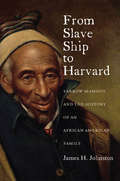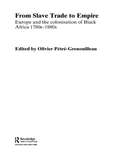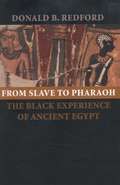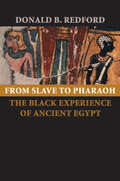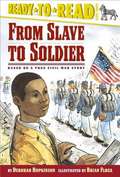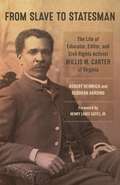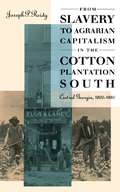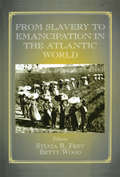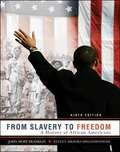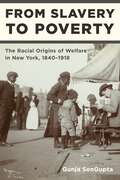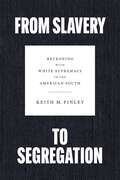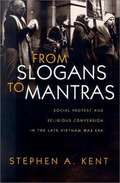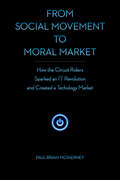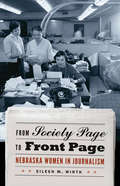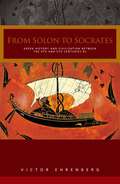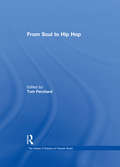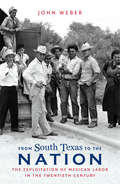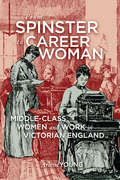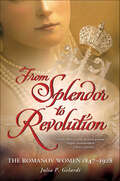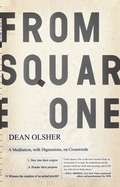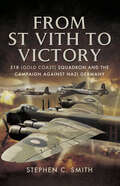- Table View
- List View
From Slave Ship to Harvard: Yarrow Mamout and the History of an African American Family
by James H. JohnstonFrom Slave Ship to Harvard is the true story of an African American family in Maryland over six generations. The author has reconstructed a unique narrative of black struggle and achievement from paintings, photographs, books, diaries, court records, legal documents, and oral histories. From Slave Ship to Harvard traces the family from the colonial period and the American Revolution through the Civil War to Harvard and finally today.Yarrow Mamout, the first of the family in America, was an educated Muslim from Guinea. He was brought to Maryland on the slave ship Elijah and gained his freedom forty-four years later. By then, Yarrow had become so well known in the Georgetown section of Washington, D.C., that he attracted the attention of the eminent American portrait painter Charles Willson Peale, who captured Yarrow’s visage in the painting that appears on the cover of this book. The author here reveals that Yarrow’s immediate relatives—his sister, niece, wife, and son—were notable in their own right. His son married into the neighboring Turner family, and the farm community in western Maryland called Yarrowsburg was named for Yarrow Mamout’s daughter-in-law, Mary “Polly” Turner Yarrow. The Turner line ultimately produced Robert Turner Ford, who graduated from Harvard University in 1927.Just as Peale painted the portrait of Yarrow, James H. Johnston’s new book puts a face on slavery and paints the history of race in Maryland. It is a different picture from what most of us imagine. Relationships between blacks and whites were far more complex, and the races more dependent on each other. Fortunately, as this one family’s experience shows, individuals of both races repeatedly stepped forward to lessen divisions and to move America toward the diverse society of today.
From Slave Trade to Empire: European Colonisation of Black Africa 1780s-1880s (Routledge Studies in Modern European History)
by Olivier Pétré-GrenouilleauMuch has been written about the origins of the great push which led Europe to colonise sub-Saharan Africa at the end of the nineteenth century. This book provides a new perspective on this controversial subject by focussing on Europe and a range of empire-building states: Germany, France, Italy and Portugal. The essays in this volume consider economic themes in addition to the political and cultural aspects of the transition from commerce to colonies.
From Slave to Pharaoh: The Black Experience of Ancient Egypt
by Donald B. RedfordIn From Slave to Pharaoh, noted Egyptologist Donald B. Redford examines over two millennia of complex social and cultural interactions between Egypt and the Nubian and Sudanese civilizations that lay to the south of Egypt. These interactions resulted in the expulsion of the black Kushite pharaohs of the Twenty-fifth Dynasty in 671 B. C. by an invading Assyrian army. Redford traces the development of Egyptian perceptions of race as their dominance over the darker-skinned peoples of Nubia and the Sudan grew, exploring the cultural construction of spatial and spiritual boundaries between Egypt and other African peoples. Redford focuses on the role of racial identity in the formulation of imperial power in Egypt and the legitimization of its sphere of influence, and he highlights the dichotomy between the Egyptians' treatment of the black Africans it deemed enemies and of those living within Egyptian society. He also describes the range of responses-from resistance to assimilation-of subjugated Nubians and Sudanese to their loss of self-determination. Indeed, by the time of the Twenty-fifth Dynasty, the culture of the Kushite kings who conquered Egypt in the late eighth century B. C. was thoroughly Egyptian itself. Moving beyond recent debates between Afrocentrists and their critics over the racial characteristics of Egyptian civilization, From Slave to Pharaoh reveals the true complexity of race, identity, and power in Egypt as documented through surviving texts and artifacts, while at the same time providing a compelling account of war, conquest, and culture in the ancient world.
From Slave to Pharaoh: The Black Experience of Ancient Egypt
by Donald B. RedfordSelected by Choice Magazine as an Outstanding Academic TitleIn From Slave to Pharaoh, noted Egyptologist Donald B. Redford examines over two millennia of complex social and cultural interactions between Egypt and the Nubian and Sudanese civilizations that lay to the south of Egypt. These interactions resulted in the expulsion of the black Kushite pharaohs of the Twenty-fifth Dynasty in 671 B.C. by an invading Assyrian army.Redford traces the development of Egyptian perceptions of race as their dominance over the darker-skinned peoples of Nubia and the Sudan grew, exploring the cultural construction of spatial and spiritual boundaries between Egypt and other African peoples. Redford focuses on the role of racial identity in the formulation of imperial power in Egypt and the legitimization of its sphere of influence, and he highlights the dichotomy between the Egyptians' treatment of the black Africans it deemed enemies and of those living within Egyptian society. He also describes the range of responses—from resistance to assimilation—of subjugated Nubians and Sudanese to their loss of self-determination. Indeed, by the time of the Twenty-fifth Dynasty, the culture of the Kushite kings who conquered Egypt in the late eighth century B.C. was thoroughly Egyptian itself.Moving beyond recent debates between Afrocentrists and their critics over the racial characteristics of Egyptian civilization, From Slave to Pharaoh reveals the true complexity of race, identity, and power in Egypt as documented through surviving texts and artifacts, while at the same time providing a compelling account of war, conquest, and culture in the ancient world.
From Slave to Soldier: Based on a True Civil War Story
by Deborah HopkinsonDuring the Civil War, African Americans struggled to be accepted as soldiers. From Slave to Soldier is fiction, but it is based on the true story of a boy named John McCline, who was enslaved on a Tennessee plantation until the age of eleven. One day in 1862 he ran away and joined a passing group of Union soldiers in the Thirteenth Michigan Infantry Regiment. Young John became a mule-team driver's helper in the Union army until the end of the Civil War. After the war John went to school and worked in hotels. In 1892 he went to work for the family of Herbert Hagerman and moved to Santa Fe, New Mexico. Around 1930 McCline showed his handwritten memoir of his early years to Hagerman, who typed it and wrote an introduction. Although it did not become a book during McCline's life, the typed copy was kept in his family and published by the University of Tennessee Press in 1998. McCline married at age eighty-six and died in 1948, when he was about ninety-five. This story is based on McCline's memory of driving a wagon alone to bring supplies to the battlefield. Years after his war experiences McCline remembered the names of all his mules, and they have not been changed in this story. Many blacks in the Union army were not treated as kindly as young McCline was. But John McCline's incredible memory for detail helps us better understand what life was like for one boy who went from being "a slave to a soldier."
From Slave to Statesman: The Life of Educator, Editor, and Civil Rights Activist Willis M. Carter of Virginia (Antislavery, Abolition, and the Atlantic World)
by Robert Heinrich Deborah Harding Henry Louis Jr.In the 1980s, Willis McGlascoe Carter’s handwritten memoir turned up unexpectedly in the hands of a midwestern antiques dealer. Its twenty-two pages told a fascinating story of a man born into slavery in Virginia who, at the onset of freedom, gained an education, became a teacher, started a family, and edited a newspaper. Even his life as a slave seemed exceptional: he described how his owners treated him and his family with respect, and he learned to read and write. Tucked into its back pages, the memoir included a handwritten tribute to Carter, written by his fellow teachers upon his death. Robert Heinrich and Deborah Harding’s From Slave to Statesman tells the extraordinary story of Willis M. Carter’s life. Using Carter’s brief memoir--one of the few extant narratives penned by a former slave--as a starting point, Heinrich and Harding fill in the abundant gaps in his life, providing unique insight into many of the most important events and transformations in this period of southern history.Carter was born a slave in 1852. Upon gaining freedom after the Civil War, Carter, like many former slaves, traveled in search of employment and education. He journeyed as far as Rhode Island and then moved to Washington, DC, where he attended night school before entering and graduating from Wayland Seminary. He continued on to Staunton, Virginia, where he became a teacher and principal in the city’s African American schools, the editor of the Staunton Tribune, a leader in community and state civil rights organizations, and an activist in the Republican Party. Carter served as an alternate delegate to the 1896 Republican National Convention, and later he helped lead the battle against Virginia’s new state constitution, which white supremacists sought to use as a means to disenfranchise blacks. As part of that campaign, Carter traveled to Richmond to address delegates at the constitutional convention, serving as chairman of a committee that advocated voting rights and equal public education for African Americans. Although Carter did not live to see Virginia adopt its new Jim Crow constitution, he died knowing that he had done all in his power to stop it. From Slave to Statesman fittingly resurrects Carter’s all-but-forgotten story, adding immeasurably to our understanding of the journey that he and men like him took out of slavery into a world of incredible promise and powerful disappointment.
From Slavery to Agrarian Capitalism in the Cotton Plantation South
by Joseph P. ReidyReidy has produced one of the most thoughtful treatments to date of a critical moment in southern history, placing the social transformation of the South in the context of 'the age of capital' and the changes in the markets, ideologies, etc. of the Atlantic world system. Better than anyone perhaps, Reidy has elaborated both the large and small narratives of this development, connecting global forces with the initiatives and reactions of ordinary southerners, black and white.--Thomas C. Holt, University of Chicago "Joseph Reidy's detailed analysis of social and economic developments in central Georgia during and after slavery will take its place among the standard works on these subjects. Its discussions of the expansion of the cotton kingdom and of the changes after emancipation make it necessary reading for all concerned with southern and African-American history.--Stanley Engerman, University of Rochester "Successfully places the experience of one region's people into the larger theoretical context of world capitalist development and in the process challenges other scholars to do the same.--Rural Sociology
From Slavery to Aid
by Benedetta RossiFrom Slavery to Aid engages two major themes in African historiography, the slow death of slavery and the evolution of international development, and reveals their interrelation in the social history of the region of Ader in the Nigerien Sahel. Benedetta Rossi traces the historical transformations that turned a society where slavery was a fundamental institution into one governed by the goals and methods of 'aid'. Over an impressive sweep of time - from the pre-colonial power of the Caliphate of Sokoto to the aid-driven governments of the present - this study explores the problem that has remained the central conundrum throughout Ader's history: how workers could meet subsistence needs and employers fulfil recruitment requirements in an area where natural resources are constantly exposed to the climatic hazards characteristic of the edge of the Sahara.
From Slavery to Emancipation in the Atlantic World
by Betty Wood Sylvia R. FreyThis collection examines the effects of slavery and emancipation on race, class and gender in societies of the American South, the Caribbean, Latin America and West Africa. The contributors discuss what slavery has to teach us about patterns of adjustment and change, black identity and the extent to which enslaved peoples succeeded in creating a dynamic world of interaction between the Americas. They examine how emancipation was defined, how it affected attitudes towards slavery, patterns of labour usage and relationships between workers as well as between workers and their former owners.
From Slavery to Freedom: A History of African Americans
by John Hope Franklin Evelyn Brooks-HigginbothamFrom Slavery to Freedom remains the most revered, respected, and honored text on the market. The preeminent history of African Americans, this best-selling text charts the journey of African Americans from their origins in Africa, through slavery in the Western Hemisphere, struggles for freedom in the West Indies, Latin America, and the United States, various migrations, and the continuing quest for racial equality. Building on John Hope Franklin's classic work, the ninth edition has been thoroughly rewritten by the award-winning scholar Evelyn Brooks Higginbotham. It includes new chapters and updated information based on the most current scholarship. With a new narrative that brings intellectual depth and fresh insight to a rich array of topics, the text features greater coverage of ancestral Africa, African American women, differing expressions of protest, local community activism, black internationalism, civil rights and black power, as well as the election of our first African American president in 2008.
From Slavery to Poverty: The Racial Origins of Welfare in New York, 1840-1918
by Gunja SenGuptaThe racially charged stereotype of "welfare queen"—an allegedly promiscuous waster who uses her children as meal tickets funded by tax-payers—is a familiar icon in modern America, but as Gunja SenGupta reveals in From Slavery to Poverty, her historical roots run deep. For, SenGupta argues, the language and institutions of poor relief and reform have historically served as forums for inventing and negotiating identity.Mining a broad array of sources on nineteenth-century New York City’s interlocking network of private benevolence and municipal relief, SenGupta shows that these institutions promoted a racialized definition of poverty and citizenship. But they also offered a framework within which working poor New Yorkers—recently freed slaves and disfranchised free blacks, Afro-Caribbean sojourners and Irish immigrants, sex workers and unemployed laborers, and mothers and children—could challenge stereotypes and offer alternative visions of community. Thus, SenGupta argues, long before the advent of the twentieth-century welfare state, the discourse of welfare in its nineteenth-century incarnation created a space to talk about community, race, and nation; about what it meant to be “American,” who belonged, and who did not. Her work provides historical context for understanding why today the notion of "welfare"—with all its derogatory “un-American” connotations—is associated not with middle-class entitlements like Social Security and Medicare, but rather with programs targeted at the poor, which are wrongly assumed to benefit primarily urban African Americans.
From Slavery to Segregation: Reckoning with White Supremacy in the American South
by Keith M. FinleyKeith M. Finley’s From Slavery to Segregation explores the key features shaping southern politics during the nineteenth and twentieth centuries as explained in the South’s defense of its racial systems. It treats slavery and segregation as part of the same whole rather than as discrete institutions rooted in different periods. In the process, the book uncovers the deep historical origins of the region’s states’ rights philosophy and the unfortunate persistence of a culture dominated by calls for white supremacy. While highlighting the broad overview of southern racial and political thought, Finley underscores the larger American struggle with racial injustice, which, although most pronounced in the South, afflicted the entire nation. The South’s defense of chattel slavery became a natural model for the region’s defense of segregation during the Jim Crow era. Through a comparative analysis of the rhetoric employed in the justification of both racial institutions, Finley reveals elements of continuity and change in the region’s identity. Ultimately, he shows how the history of the twentieth-century South is irreparably linked to the century before it. For instance, one cannot understand the ferocity of resistance to the Supreme Court’s 1954 Brown v. Board decision without being aware of how and why the South emerged as it did after the Civil War. The Old South and the New South shared a similar constellation of ideas that informed arguments advancing their respective race-based social orders, which took the form of a commonality of perception regarding race, a sense of being assailed by outsiders, and a series of appeals to the highest secular authority in the pantheon of regional and American beliefs—the Constitution. Discontinuity, however, marked the long-term strategies of both the prewar and postwar South. Although segregationists sought to preserve the racial status quo as did their forebears, they ultimately relented when confronted with federal power and grudgingly shifted toward a narrative that less often foregrounded race when championing states’ rights.
From Slogans to Mantras: Social Protest and Religious Conversion In The Late Vietnam War Era
by Stephen A. KentThe author has sought out and interviewed many of the folks who first too part in politics and later in radical religious conversions during the sixties.
From Social Movement to Moral Market: How the Circuit Riders Sparked an IT Revolution and Created A Technology Market
by Paul-Brian McinerneyIn From Social Movement to Moral Market, Paul-Brian McInerney explores what happens when a movement of activists gives way to a market for entrepreneurs. This book explains the transition by tracing the brief and colorful history of the Circuit Riders, a group of activists who sought to lead nonprofits across the digital divide. In a single decade, this movement spawned a market for technology assistance providers, dedicated to serving nonprofit organizations. In contrast to the Circuit Riders' grassroots approach, which was rooted in their commitment to a cause, these consultancies sprung up as social enterprises, blending the values of the nonprofit sector with the economic principles of for-profit businesses. Through a historical-institutional analysis, this narrative shows how the values of a movement remain intact even as entrepreneurs displace activists. While the Circuit Riders serve as a rich core example in the book, McInerney's findings speak to similar processes in other "moral markets," such as organic food, exploring how the evolution from movement to market impacts activists and enterprises alike.
From Society Page to Front Page: Nebraska Women in Journalism
by Eileen WirthEileen M. Wirth never set out to be a groundbreaker for women in journalism, but if she wanted to report on social issues instead of society news, she had no alternative. Her years as one of the first women reporters at the Omaha World-Herald, covering gender barriers even as she broke a few herself, give Wirth an especially apt perspective on the women profiled in this book: those Nebraskans who, over a hundred years, challenged traditional feminine roles in journalism and subtly but surely changed the world.The book features remarkable women journalists who worked in every venue, from rural weeklies to TV. They fought for the vote, better working conditions for immigrants, and food safety at the turn of the century. They covered wars from the Russian Revolution to Vietnam. They were White House reporters and minority journalists who crusaded for civil rights. Though Willa Cather may be the only household name among them, all are memorable, their stories affording a firsthand look into the history of journalism and social change.
From Sofia to Jaffa: The Jews of Bulgaria and Israel (Raphael Patai Series in Jewish Folklore and Anthropology)
by Raphael Patai Guy H. HaskellWithin two years of the establishment of the State of Israel in 1948, an astounding 45,000 of Bulgaria's 50,000 Jews left voluntarily for Israel. This mass exodus was remarkable considering that Bulgaria was the only Axis power to prevent the deportation of its Jews to the death camps during World War II. After their arrival in Israel, the Jews of Bulgaria were recognized as a model immigrant group in a fledgling state attempting to absorb hundreds of thousands of newcomers from more than eighty countries. They became known for their independence, self-reliance, honesty, and hard work. <P><P> From Sofia to Jaffa chronicles the fascinating saga of a population relocated, a story that has not been told until now. Beginning with a study of the community in Bulgaria and the factors that motivated them to leave their homeland, this book documents the journey of the Bulgarian Jews to Israel and their adaptation to life there.
From Solon to Socrates: Greek History and Civilization During the 6th and 5th Centuries BC
by Victor EhrenbergFrom Solon to Socrates is a magisterial narrative introduction to what is generally regarded as the most important period of Greek history. Stressing the unity of Greek history and the centrality of Athens, Victor Ehrenberg covers a rich and diverse range of political, economic, military and cultural issues in the Greek world, from the early history of the Greeks, including early Sparta and the wars with Persia, to the ascendancy of Athens and the Peloponnesian War.
From Solon to Socrates: Greek History and Civilization During the 6th and 5th Centuries BC (Routledge Classics Ser.)
by V. EhrenbergFirst published in 1973. Routledge is an imprint of Taylor & Francis, an informa company.
From Soul to Hip Hop (The\library Of Essays On Popular Music Ser.)
by Tom PerchardThe essays contained in this volume address some of the most visible, durable and influential of African American musical styles as they developed from the mid-1960s into the 21st-century. Soul, funk, pop, R&B and hip hop practices are explored both singly and in their many convergences, and in writings that have often become regarded as landmarks in black musical scholarship. These works employ a wide range of methodologies, and taken together they show the themes and concerns of academic black musical study developing over three decades. While much of the writing here is focused on music and musicians in the United States, the book also documents important and emergent trends in the study of these styles as they have spread across the world. The volume maintains the original publication format and pagination of each essay, making for easy and accurate cross-reference and citation. Tom Perchards introduction gives a detailed overview of the book‘s contents, and of the field as a whole, situating the present essays in a longer and wider tradition of African American music studies. In bringing together and contextualising works that are always valuable but sometimes difficult to access, the volume forms an excellent introductory resource for university music students and researchers.
From South Texas to the Nation: The Exploitation of Mexican Labor in the Twentieth Century (The David J. Weber Series in the New Borderlands History)
by John WeberIn the early years of the twentieth century, newcomer farmers and migrant Mexicans forged a new world in South Texas. In just a decade, this vast region, previously considered too isolated and desolate for large-scale agriculture, became one of the United States' most lucrative farming regions and one of its worst places to work. By encouraging mass migration from Mexico, paying low wages, selectively enforcing immigration restrictions, toppling older political arrangements, and periodically immobilizing the workforce, growers created a system of labor controls unique in its levels of exploitation.Ethnic Mexican residents of South Texas fought back by organizing and by leaving, migrating to destinations around the United States where employers eagerly hired them--and continued to exploit them. In From South Texas to the Nation, John Weber reinterprets the United States' record on human and labor rights. This important book illuminates the way in which South Texas pioneered the low-wage, insecure, migration-dependent labor system on which so many industries continue to depend.
From Spinster to Career Woman: Middle-Class Women and Work in Victorian England
by Arlene YoungThe late Victorian period brought a radical change in cultural attitudes toward middle-class women and work. Anxiety over the growing disproportion between women and men in the population, combined with an awakening desire among young women for personal and financial freedom, led progressive thinkers to advocate for increased employment opportunities. The major stumbling block was the persistent conviction that middle-class women - "ladies" - could not work without relinquishing their social status. Through media reports, public lectures, and fictional portrayals of working women, From Spinster to Career Woman traces advocates' efforts to alter cultural perceptions of women, work, class, and the ideals of womanhood. Focusing on the archetypal figures of the hospital nurse and the typewriter, Arlene Young analyzes the strategies used to transform a job perceived as menial into a respected profession and to represent office work as progressive employment for educated women. This book goes beyond a standard examination of historical, social, and political realities, delving into the intense human elements of a cultural shift and the hopes and fears of young women seeking independence. Providing new insights into the Victorian period, From Spinster to Career Woman captures the voices of ordinary women caught up in the frustrations and excitements of a new era.
From Spitfires to Vampires and Beyond: A Kiwi Ace's RAF Journey
by Owen HardyWorld War Two Spitfire pilot Owen Hardy was probably the last New Zealand ace to tell his story. He left home at 18 bent on joining the RAF and by 1942, aged only 20, he was at Biggin Hill with 72 Squadron under Brian Kingcome. D-Day found him flying over the Normandy beaches with 485 (New Zealand) Squadron. That he survived the war unharmed owed as much to luck as it did to his ability as a fighter pilot. Unable to settle in civilian life afterwards in New Zealand, he returned to the RAF for the second phase of a remarkable career. Converting to jets, Hardy went on to command 71 Squadron, leading a Vampire aerobatic team with considerable success across Europe – dodging MiGs at the same time! But adapting to peacetime service wasn’t easy. Previously stimulated by the wartime environment and still passionate about flying, he was less enamored with staff jobs; and this despite working on the introduction of a new, state-of-the-art missile system, Bloodhound. Then a fateful decision, to turn down command of a Javelin squadron and follow his mentor, led finally to disillusionment. Hardy pulls no punches in this forthright and refreshingly honest autobiography. In retelling his eye-opening story, editor Black Robertson shines a light on what it was like not just to fly in combat, but also on the changing face of a post-war RAF which arguably undervalued some of its heroes. From the heat of North Africa to the uncertainties of the Cold War, it’s a unique and enthralling tale.
From Splendor to Revolution: The Romanov Women 1847–1928
by Julia P. Gelardi“A richly detailed portrait of four women, whom marriage and blood put at the center of European history.” —Richmond Times-DispatchThis sweeping saga recreates the extraordinary opulence and violence of Tsarist Russia as the shadow of revolution fell over the land and destroyed a way of life for these Imperial women.From the early 1850s until the late 1920s Russia underwent a massive transformation, taking it from days of grandeur under the tsars to the chaos of revolution and the beginnings of the Soviet Union.At the center of all this tumult were four Romanov women. Marie Alexandrovna, Tsar Alexander II’s pampered daughter, astonished her mother-in-law, Queen Victoria, with her strength of character. Thrust into the role of queen at sixteen, Olga Constantinovna’s altruistic streak benefited Greeks and Russians alike. Charming and vivacious, Marie Feodorovna, the mother of the ill-fated Tsar Nicholas II, excelled in her role as empress. Formidable and ambitious, Marie Pavlovna emerged as a rival to Tsarina Alexandra, Nicholas II’s embattled consort.From Splendor to Revolution presents the unforgettable political and personal dramas of these extraordinary women. What began for them as a time of splendor ended after World War I, with a Russia destroyed by revolution.“Relating the drama and tragedy of royal life, Gelardi ably weaves in the extended family ties that connected most European rulers, including Queen Victoria.” —Publishers Weekly (starred review)“Simple, straightforward, and engaging. Gelardi is proof that history written from the female perspective can be all business.” —The Roanoke Times
From Square One
by Dean OlsherFrom Square One is Dean Olsher's captivating and in-depth exploration of the cultural history, psychology, and even metaphysics of crosswords -- their promise of a world without chaos and uncertainty. It is often repeated that more than 50 million Americans do crossword puzzles on a regular basis. Skeptical of that claim, Dean Olsher does his own research and finds that the number is nearly dead-on. Filled with lively, original reporting, From Square One disputes the widely held belief that solving crosswords helps prevent Alzheimer's; in fact, the drive to fill in empty spaces is more likely a mental illness than a cure. While "puzzle addiction" is usually meant as a lighthearted metaphor, the term contains more than a nugget of truth. Olsher looks into the origins and traditions of this popular pastime, which made its debut in a New York newspaper in 1913. Or did it? Along the way, he takes readers inside the making of a crossword. He also revives the quest of musical-theater legend and puzzle constructor Stephen Sondheim to find an American audience for a British crossword style that demands a love of verbal playfulness over knowledge of arcane trivia. Informative, engaging, and often surprising, From Square One is a unique and enjoyable read for puzzlers and nonpuzzlers alike.
From St Vith to Victory: 218 (Gold Coast) Squadron and the Campaign Against Nazi Germany
by Stephen C. SmithCompiled from a variety of sources and first-hand accounts, this book is an authoritative record of the part played by No.218 (Gold Coast) Squadron during the bomber offensives of World War II. The squadron's activities are described in detail offering a unique insight into the lives of those involved and saluting the important role that No.3 Group and No.218 Squadron played in Bomber Command's ultimate victory.No.218 Squadron was formed a few months before the Armistice which brought to a conclusion the Great War. Disbandment soon followed, rendering the squadron number plate dormant until the rise of National Socialism in Germany. The squadron was reformed in 1936 and spent the remaining peace time years honing its skills, skills that would be tested from the very first day of the bomber offensive against Germany to the very last.
